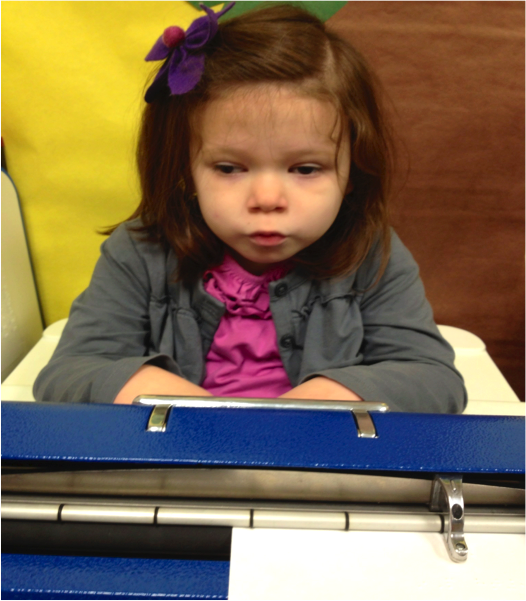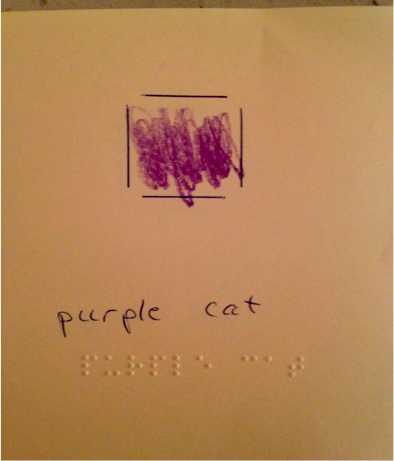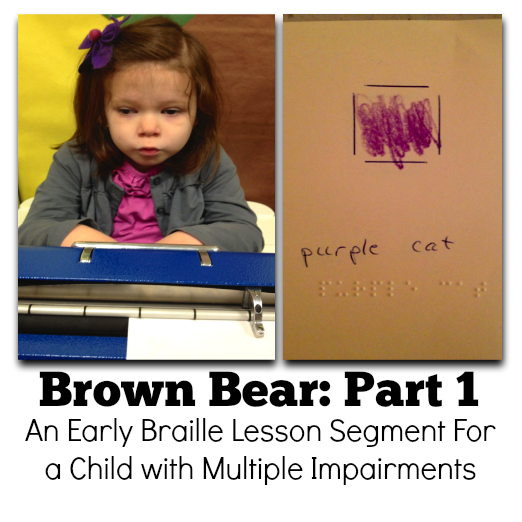 THE BIG PICTURE
THE BIG PICTURE
In my iBook “
Introducing Braille,” I largely used videotaped examples of bright, enthusiastic young students to show ways to “Make It Fun,” “Make it Developmental,” and “Make It Meaningful”. Recently, I posted a video here on Paths to Literacy with a lesson segment of an early braille student whom I anticipated would stay roughly on grade level. (“
Find the Boy: Video Introducing Braille Literacy through Assistive Technology”) My comments were through the lens of “Introducing Braille.” But what does fun, developmental, and meaningful look like when introducing braille to struggling readers with multiple impairments?
ALISON
Alison is an 8-year-old girl with total blindness due to congenital cataracts, and a mild conductive hearing loss in one ear. She has diagnoses of low tone, a heart defect, a slowed physical growth that affects her internal organs as well as her overall height, and a significant developmental delay. She understands some spoken words and phrases; she does not talk or use a communication device but she uses five or six signs upon request. Her mother graciously videotaped the attached literacy activities during a home visit. Alison was obviously unhappy about the session, but she participated more than her mother expected, and couldn’t totally disguise her curiosity about what was going on.
 VIDEO SUMMARY
VIDEO SUMMARY
The focus of this 57-second video is braille reading and writing related to the classic “Brown Bear” book by Eric Carle. (See link below.) Alison’s mother had read Brown Bear to her for years, and it was special to both of them. In order to create very short segments divided by breaks of turning pages, I brailled only key phrases on each page (“brown bear” on one page, “blue horse” on another, etc.) and asked one of the children in Alison’s inclusion class to color in the squares. In this taped lesson segment, I begin by guiding Alison in reading the “blue horse” page. She reluctantly accepts assistance to track from left to right with her one hand as I voice the words.
Next, I move the book aside and put the brailler in front of Alison in order to integrate her reading and writing by having her write the first letter of the word she had just read. She whimpers and quickly brings both hands behind her neck. I knew from past lessons that Alison often joined in if I kept up momentum, so I guide her left hand to the brailler and ask her to write “b” for “blue horse.” She clearly resists but she allows me to lead her in pressing dots 1 and 2 for “b” and then to lead her hand to the embosser to read the “b.” I was pleased to see that she explores with her hand for a few seconds on her own at this point.
Back to reading, Alison participates with me in page turning. (She turns two pages rather than one.) I try to entice her with my enthusiasm, “Now look at this page!” It says, “Purple cat!” “You know purple. That’s one of your letters!” Alison allows me to guide her hand in tracking this line.
I again set the book aside and guide Alison’s hand, encouraging her to write the letter “p.” She seems to have grasped the pattern of the tasks, and does this step with minimal assistance. After writing “p,” Alison then independently presses more keys with clear finger isolation. I exclaim, “You’re writing some more letters while you’re at it!” “Write some more letters!” “Good writing.”
GUIDELINES FOLLOWED
-
To “Make it Developmental,” for Alison, I asked her to read only two words per page of an already familiar book, I chose words with initial letters that were relatively easy to write, and asked her to write only one letter to correspond to each page. Where possible, such as in writing the letter “b,” I allowed her to write with just one hand. (It seemed more developmentally appropriate that she write one letter successfully than that she keep both hands on the brailler keyboard. This could follow later.) When Alison turns more than one page at a time, I gladly accept this approximation.
-
To “Make in Fun,” I used a favorite book, I showed Alison my own enthusiasm, I guided as gently as I felt I could in order to maintain momentum, and I praised Alison’s child-led “scribbling” at the end of the segment. (This initiative is unusual for her. I was obviously thrilled!)
-
To “Make it Meaningful, I began by scheduling the lesson at home. Alison’s mother had spent lots of time reading to her at home; I wanted Alison to make a link between what she and I were doing at school with her reading at home, and I wanted to model my instruction for her mother. I also aimed for meaningfulness in choosing this particular book because her inclusion class at school is reading it. (One darling little boy even sings it to her.) I also tried to build in meaningfulness for Alison by binding her own 2-words-per-page copy like a book, by integrating reading and writing, by asking her two write lines with letters she already knew (‘b” for “blue horse” and “p” for “purple cat.” Lastly, I tried to tap into her prior knowledge of these letters (“You know ‘p,’ that’s one of your letters.”)
NOTE: As I prepared this blog entry, watching and re-watching the video, I did some reflection about my own teaching. Frankly, I had some doubts. Had I stepped back in every way that I possibly could have? In an upcoming post of Brown Bear: Part 2, I will share my thinking on this.
The author presented this material at the NE AER Conference in November 2015 in North Falmouth, Massachusetts.
 THE BIG PICTURE
THE BIG PICTURE VIDEO SUMMARY
VIDEO SUMMARY
